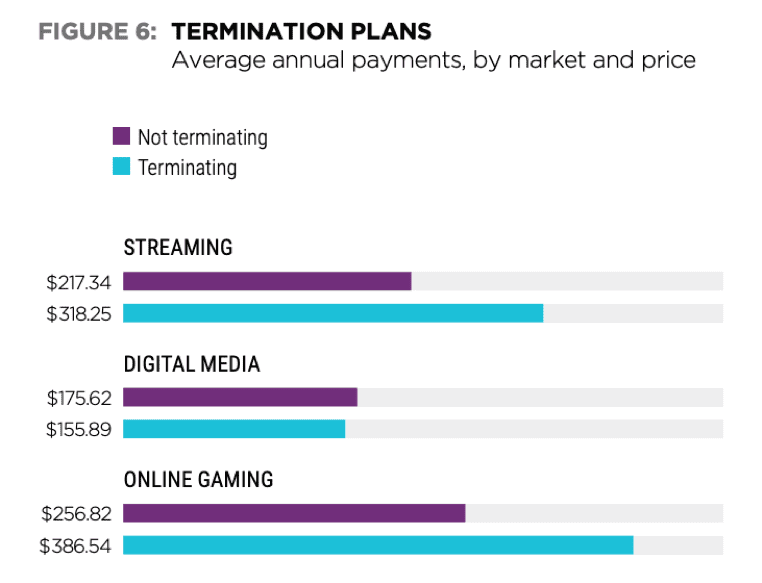Ownership has been largely replaced with so-called subscription commerce. Instead of owning DVDs, consumers subscribe to Netflix, and rather than buying — or even downloading — albums, consumers pay a monthly fee to Spotify to access practically any music they might want. Books and games have also gone digital with Audible or Xbox Game Pass to allow consumers to read or play on-demand.
While convenient, this approach depends on consumer loyalty. Streaming services have to retain customers who might only subscribe to Netflix or HBO Go for a particular show. When that show ends, some might flee or change services.
The new Subscription Commerce Conversion Index analyzes the challenges providers face in creating subscriber loyalty and includes insights from a survey of 2,153 consumers and highlights what digital content subscription companies can do to keep subscribers engaged.
Streaming is by far the most popular type of subscription service. Seventy percent of consumers subscribed to at least one streaming service. Online gaming services were the second-most common at 30.6 percent, followed by digital media services at 27.7 percent. Only 16.7 percent did not subscribe to any service.

More than twice the number of consumers subscribed to streaming services as those who subscribed to online gaming, indicating that streaming services have a better chance at retaining subscribers than the others.
While the largest concentration of consumers had maintained their subscriptions for one to two years: 18.2 percent for streaming, 24 percent for digital media and 19.8 percent for online gaming, streaming services had the largest number of consumers who had subscribed for five years or more (17.4 percent).
That loyalty is why only 8 percent of streaming subscribers planned to end their subscriptions in the next year.

The first month is crucial for providers since the first 30 days is when new customers are most likely to cancel. More than half (52.2 percent) of online gaming subscribers plan to cancel after the first month, while 70.7 percent of digital media subscribers feel the same. Over one-third (36.2 percent) of streaming subscribers think about abandoning the service after the first month. The longer streaming subscribers maintain their relationships, the less likely they are to leave those services.
There are countless reasons why subscribers end services, but the biggest factor is cost. Nearly one-quarter (22.8 percent) said they could no longer afford a subscription they planned to cancel. Close to the same number didn’t see the value (20.6 percent) or no longer wanted the content (20.6 percent). Others used up their free trial, switched to a preferred provider, could obtain the service from others or were frustrated by price increases.

Factors like poor product reviews, difficulty of use, inconsistent quality and lack of live help had less bearing on a decision to cancel. But some of these lesser reasons had more impact on certain types of subscriptions. For example, digital media subscribers were the most likely to cancel due to lack of live help (42.3 percent), poor product reviews (38.5 percent) and a difficult to use service (33.3 percent). Online gaming subscribers were most likely to cancel because of poor product descriptions (52.6 percent).
How much does price affect loyalty? There was roughly a $100 difference between the annual streaming fees of subscribers who planned to cancel and those who didn’t. More than the amount that would take an online gaming subscriber to cancel. Digital media subscribers were a different case. Those that planned to cancel were paying slightly less than those who planned to keep the service, which implies that digital media subscriber attrition has less to do with price than for streaming or online gaming.

First impressions matter and streaming services received higher marks concerning the initial onboarding process than others; 90.7 percent said they were “very” or “extremely” satisfied with onboarding for streaming services compared to 82.5 percent for digital media and 83.3 percent for online gaming.
Sometimes satisfaction actually has less to do with reality, however, and more with perception. While streaming subscribers were the most satisfied with the onboarding process and least likely to cancel service, there was a disconnect between features customers thought a service offered and what a service actually provided.
A majority 62.4 percent) of streaming customers believed their subscription companies offered plan changes, but only 45.5 percent of them did so. And there was an even larger gap between subscribers and providers in terms of product ratings, with 75.6 percent of customers saying these features were available but only 13.6 percent of firms actually offering them.
What does this mean? Streaming may currently fare better than digital media services, but both segments would be wise to understand what affects consumers’ impressions. These disparities present areas in which streaming services can improve to boost their subscribers’ satisfaction.